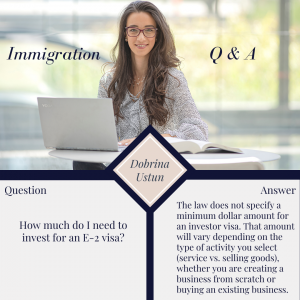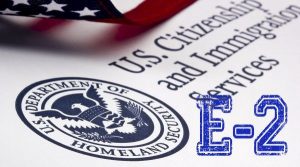Who are Qualified as E2 Treaty Investors?
To qualify for E-2 classification, the treaty investor must:
- Be a national of a country with which the United States maintains a treaty of commerce and navigation
- Have invested, or be actively in the process of investing, a substantial amount of capital in a bona fide enterprise in the United States
- Be seeking to enter the United States solely to develop and direct the investment enterprise
- This is established by showing at least 50% ownership of the enterprise or possession of operational control through a managerial position or other corporate devices
What is Considered as “Investment” In the Context of E-2?
- Investment is the treaty investor’s placing of capital, including funds and/or other assets, at risk in the commercial sense with the objective of generating a profit
- The capital must be subject to partial or total loss if the investment fails
- The treaty investor must show that the funds have not been obtained, directly or indirectly, from criminal activity
What Counts as a “Substantial” Amount of Capital?
A substantial amount of capital is:
- Substantial in relationship to the total cost of either purchasing an established enterprise or establishing a new one
- Sufficient to ensure the treaty investor’s financial commitment to the successful operation of the enterprise Of a magnitude to support the likelihood that the treaty investor will successfully develop and direct the enterprise. The lower the cost of the enterprise, the higher, proportionately, the investment must be to be considered substantial
- A bona fide enterprise refers to a real, active, and operating commercial or entrepreneurial undertaking which produces services or goods for profit. It must meet applicable legal requirements for doing business within its jurisdiction
However, the investment enterprise may not be “marginal”.
Marginal Enterprise
“A marginal enterprise is one that does not have the present or future capacity to generate more than enough income to provide a minimal living for the treaty investor and his or her family”
What If the Principal Alien Employer is Not an Individual?
- If the principal alien employer is not an individual, it must be an enterprise or organization at least 50% owned by persons in the United States who have the nationality of the treaty country
- These owners must either: (a) be maintaining nonimmigrant treaty investor status or (b) if the owners are not in the United States, they must be, if they were to seek admission to this country, classifiable as nonimmigrant treaty investors
See 8 CFR 214.2(e)(3)(ii).
E-2 Specialist or Essential Skilled Workers
For an employee to qualify for this category, they must be highly skilled level people. It must be demonstrated in the petition that the employee:
- The employee has specialized knowledge of the enterprise which may not be easily found in the United States
- It is necessary to bring the employee to the United States for the efficient operation of the enterprise
E-2 Managers, Executives, and Supervisors
Under this category, the employee must meet any of the above three descriptions:
- E-2 managers and executives should be those in top positions and manage an entire structure of the business or a critical part of the business
- If it is a larger business, the principal investor may not even spend much time in the United States
- In such instances, the E-2 employee who will oversee the business operation must demonstrate the managerial or executive skills required for the smooth running of the enterprise
- Relevant supporting documents such as resume, job description, and supporting letter must also reflect the employee’s ability and experience in such roles
Is the Sponsorship Process Different For E-2 Workers Who is Already in the USA?
- If the treaty investor is currently in the United States in a lawful nonimmigrant status, they may file Form I-129 to request a change of status to E-2 classification
- If the desired employee is currently in the United States in a lawful nonimmigrant status, the qualifying employer may file Form I-129 to request a change of status to E-2 classification on the employee’s behalf
You can access all the Forms here
For DS-156E: Nonimmigrant Treaty Trader / Investor Application, Click here
However, If You are Outside the U.S.A:
- If you are outside the U.S. and need to use consular processing, then you will need to pay a $205 filing fee for your DS-160 visa application cost
- There is also a biometric services fee of $85
- If your spouse or dependents are going to accompany you, an I-129 petition will need to be filed for each visa issued along with the required filing fee
- No rules govern who pays, but since the employer signs and submits the petition, the employer generally produces the payment as a practical matter.
- Check the USCIS website for the filing fee and location just before filing, as both change periodically
You can access all the Forms here
You can find the fee schedule here
How to Apply for an E-2 Visa at an Embassy or Consulate Abroad?
This process can be broken down into three broad steps:
- Either you or your employer has to prepare, and submit, Form DS-160 (a generic nonimmigrant visa application) online
- Your employer should prepare and submit a paper filing consisting of Form DS-156E (nonimmigrant treaty trader/ investor application) with a confirmation page from DS-160 and supporting documents
- Then you as an employee need to attend an interview at a consular post
Form DS-160
- The form can be accessed at https://ceac.state.gov/genniv/
- The form is presented as a sequence of screens, each asking for a small amount of information
- You can also save the form and come back to it later, by recording the application number
- You will be assigned a number on the first screen
After “signing” the application and submitting it online, your employee should print out the confirmation page for filing at the consular post along with the packet of E-2 supporting documents
Preparing and Submitting Form DS-156E and Supporting Documents
- After the E-2 online application has been submitted, you will need to complete the E-2 visa application through a paper filing with the consular post
- The E-2 visa packet comprises the confirmation page from the online DS-160 application along with Form DS 156E and supporting documents
- Though all U.S. consular posts use this same form to collect E-2 qualifying information, they vary as to what they expect to see in the E-2 visa packet and how they want it presented
- Check for specific instructions at consular post websites, before assembling the E-2 visa packet
Relevant Documents You Can Submit to Establish E-2 Requirements:
- Evidence of possession and control of investment funds: bank records, financial statements, loans, savings, promissory notes
- Evidence of remittance of funds to the U.S.: bank drafts, transfers, exchange permits, receipts
- Evidence of establishment of business in the U.S.: articles of incorporation, partnership agreements, organization and staffing charts, shares, titles, contracts, receipts licenses, leases
- Evidence of investors’ nationality: passports, articles of incorporation of the parent company, stock exchange listings
- Evidence of investment in the U.S.: titles, receipts, contracts, loans, bank statements
- Evidence of the substantiality of the investment: financial statements, audits, corporate tax returns
- Evidence that the enterprise is not marginal: payroll records, payroll tax forms, personal tax returns, or other evidence of personal income and assets
- Evidence that the enterprise is a real, operating business: annual reports, catalogs, sales literature, news articles
- Evidence of the qualifications of the prospective employee: resume, diplomas, certificates
Preparing For the Consular Interview
- Every consular post has its own procedures for scheduling and conducting visa interviews, look for specific instructions before attending the interview
- At the interview, you as an E-2 visa applicant can expect close questioning about the nature of the work to be performed in the U.S. and your qualifications to perform that work
- Make sure to give your prospective employee an opportunity, before going in for the interview, to review the E-2 visa packet you submitted to the consular post
- Your prospective E-2 employee should be coming to the U.S. for a limited stay, intending to return when the temporary E-2 employment ends
How to Maintain E-2 Status in The U.S.?
- On approving an E-2 petition, USCIS issues an approval notice to the employer that includes a status document for the employee
- The employer and employee must track the expiration date on the I-94. Typically, E-2 status is granted for an initial two-year term
- Before the I-94 expires, the employer can extend your employee’s status by filing a second petition with USCIS
- Theoretically, E-2 status can be extended indefinitely by the filing of a petition every two years
- But USCIS does require persuading anew each time, and employers are frequently asked to present some evidence that U.S. workers are not available for the job in question
- With each reentry during the life of the visa, the immigration officer at the point of entry should grant a new two-year period of stay so on and so forth
If you have any questions about the E-2 visa renewal or anything else about this Treaty Investor or employee eligibility talk to us. Talk to a reliable immigration attorney to explore the E1 and E2 visa options.
Schedule a call at 469-994-9407 please contact us using the form.



